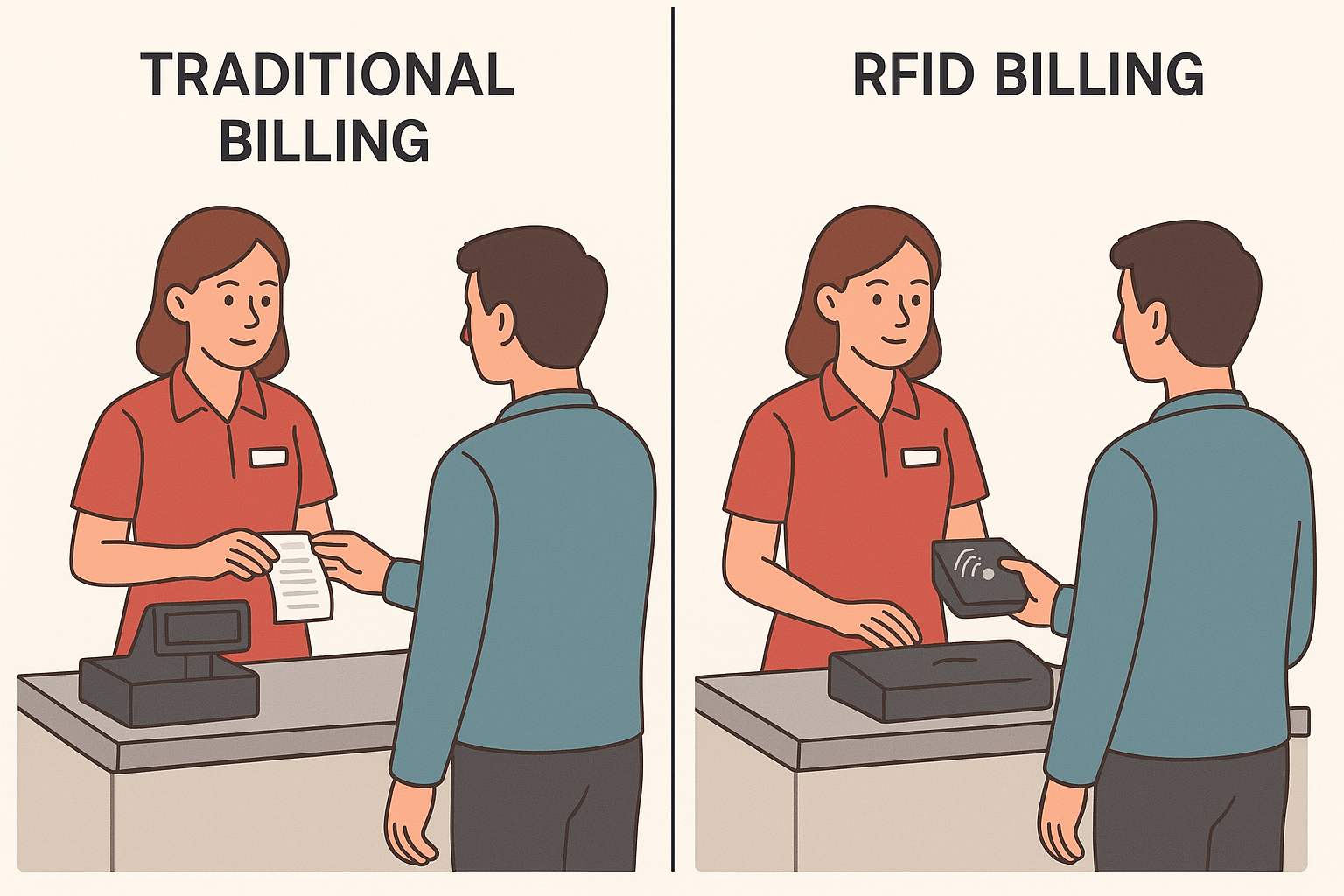In every supermarket, retail store, billing is the final and most crucial step in the customer journey. It is the moment where convenience, technology, and time management come together. For decades, we have been using traditional billing system such as barcodes, manual scanning, and human operated counters. But with changing times, increasing crowd levels, and the demand for faster service, a smarter solution has emerged: RFID Billing Stations.
Let’s understand what these systems are, how they work, and why RFID billing is a good way for businesses to handle queues and customer satisfaction.
What is Traditional Billing?
Traditional billing refers to the manual process of scanning each product’s barcode at the counter, generating an itemized bill, and collecting payment. It has been the standard method across supermarkets, apparel stores, pharmacies, etc
How it works :
Each product carries a barcode label.
The cashier uses a barcode scanner to scan every product one by one.
The system identifies the product name, price, and stock details.
Once all items are scanned, the bill is generated and payment is processed.
Advantages of traditional billing :
Simple to implement and widely understood.
Low initial setup cost.
Reliable for small stores with limited transactions.
But there are some limitations too :
Scanning each product takes time.
Long queues form during peak hours.
Barcodes can get damaged or unreadable.
It heavily depends on staff skill.
While traditional billing has served well for years, it struggles to match today’s speed and automation needs especially in crowded environments or when contactless operations are required.

What is an RFID Billing Station ?
RFID stands for Radio Frequency Identification. In an RFID billing system, products are tagged with RFID tags instead of barcodes. These tags contain digital information that can be read wirelessly by an RFID reader without needing line of sight scanning.
An RFID billing station is a smart counter where a reader automatically detects all tagged items placed on or near it, instantly generating the bill within seconds.
How it works :
Each product carries an RFID tag encoded with unique product details.
The staff places all items in the billing tray or area equipped with the RFID reader.
The reader automatically scans all the tags simultaneously.
The software displays the complete list of items, quantities, and prices in one go.
The customer can review and make payment through cash, card, or digital mode.
That’s it no manual scanning is needed in this process
RFID Billing in Action – A Simple Example
Now, let’s look at the same situation with an RFID billing station. Here, the staff doesn’t need to scan each product manually. Instead, they simply take the customer’s basket, place all the items on the RFID billing tray, and within 2–3 seconds, the system automatically reads all the RFID tags. The entire list of items instantly appears on the screen. The bill is ready, payment is done, and the customer leaves all within a minute or two.
In the traditional way, the staff would have to:
Pick up each item,Find the barcode,Scan it carefully,Wait for the system to identify it,Then move to the next product.
If there are 10 or 15 items, this whole process could easily take 5 minutes per customer sometimes even more if the barcodes are faded or misplaced.
But with RFID billing, all items are detected at once using radio frequency signals, even if they are inside a basket or not directly visible. This drastically reduces billing time and human effort, especially during peak hours.
Key Features of RFID Billing Stations :
Instant multi-item detection: Reads multiple products at once without line of sight scanning.
Faster checkout: Reduces billing time from minutes to seconds.
Accuracy: Minimises human errors in scanning and billing.
Contactless operation: Ideal for post- andemic retail environments where hygiene is important.
Integration ready: Works with existing POS (Point of Sale) and inventory systems.
Anti-theft support: Can be integrated with RFID based EAS (Electronic Article Surveillance) for security.
Use Case Scenarios :
-
Supermarkets and Hypermarkets :
In large retail stores, customers often face long queues at checkout counters, especially during weekends or festive seasons. RFID billing counters speed up the process , customers simply drop their basket, get the bill instantly, and move out. This improves customer satisfaction and allows stores to handle more transactions per hour.
-
Fashion and Apparel Stores :
RFID tags are already popular in clothing stores for inventory tracking. The same tags can be used for billing too. At the counter, the system detects all garments instantly, avoiding the need to remove hangers or unfold items to find barcodes.
-
Airports and Duty Free Shops :
At airports where passengers are in a hurry, RFID billing helps speed up purchases at duty free shops.
-
Pharmacies and Healthcare Stores :
RFID billing ensures quick billing for prescriptions. It reduces the chances of scanning errors and helps maintain a record of medicine sales .
Why RFID Billing Matters in Crowded Times :
In today’s fast moving shopping world, time equals customer satisfaction. People no longer have the patience to wait in long queues. During peak seasons, even an additional 30 seconds per customer can lead to hour long queues at billing counters.
RFID billing counters are designed to handle such crowded scenarios easily. They can process multiple customers quickly, with minimal staff involvement. During situations like the COVID-19 pandemic, where contactless transactions became crucial, RFID systems proved extremely useful by reducing human touchpoints.
Moreover, with growing competition among retailers, faster billing becomes a competitive advantage. Customers are more likely to return to a store where checkout is faster and stress free
The Shift Towards Smart Retail :
Many Indian retailers are slowly shifting from barcode to RFID based systems. Initially, the investment may seem high since it involves RFID tags, readers, and compatible software but the long term benefits are significant:
Reduced manpower at billing counters.
Faster throughput and customer satisfaction.
Real time stock updates and shrinkage control.
Better space management due to shorter queues.
As more stores embrace digital transformation, RFID billing will soon become a standard feature in smart stores, just like barcode systems were two decades ago.
Final Thoughts :
The difference between traditional billing and RFID billing is not just about technology it’s about the customer experience. Traditional systems rely on manual effort and patience, while RFID billing represents automation, speed, and convenience.
In a world where every second counts, RFID billing stations bridge the gap between human efficiency and technological precision. Whether in supermarkets, Pharmacies or airports this innovation is changing how we think about queues, payments, and customer comfort.

